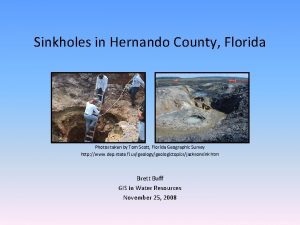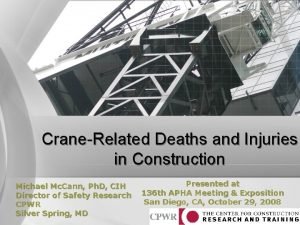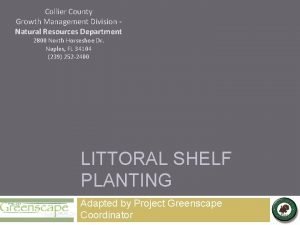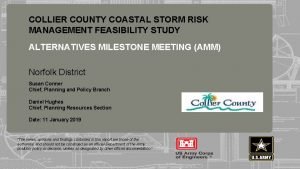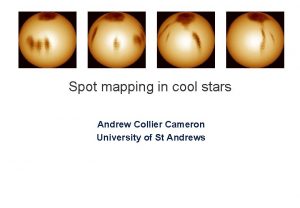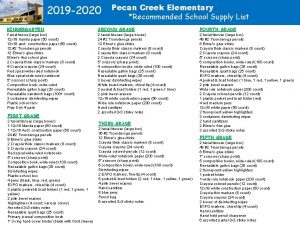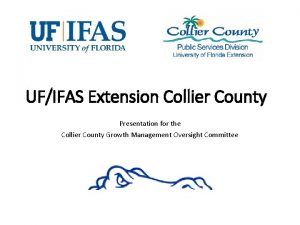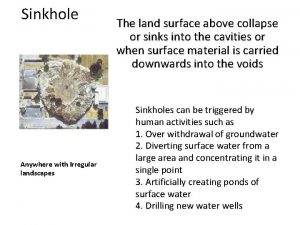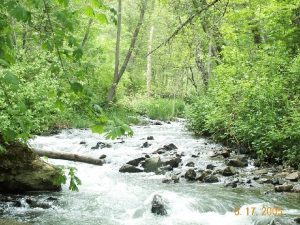Sinkhole Collapses in Middle Creek Collier Drive Sevierville
















































- Slides: 48

Sinkhole Collapses in Middle Creek Collier Drive, Sevierville, TN

History In 2010 a sinkhole developed adjacent to Middle Creek under the Collier Drive Bridge within the city of Sevierville Right-of-Way. It was determined that the development had caused a break in a city water line and was capturing the flow of the creek itself. The city immediately took steps to reroute the water line and stabilize the bridge; however, they did not deal with the sinkhole itself and the loss of the creek. After numerous discussions and meetings, it was decided that since this appeared to be a natural occurrence and was affecting waters of the state, the Department of Environment and Conservation should take action to try to correct the situation.

On July 18 th, 2010, the state of TN Department of Environment and Conservation began work to stabilize the large sinkholes developing under the Collier Drive bridge and provide a pathway for surface water to flow again. The city of Sevierville agreed to provide logistic support to this undertaking.
























On August 12 th, 2011, a phone call was received from the city engineer reporting that an additional sinkhole had developed just upstream of the bridge outside of our previous work area. The sinkhole was extremely large and was capturing the entire flow of the stream once again. In addition, it was threatening an 8 -inch sewer line from a nearby business.

We arrived on site Friday afternoon, August 12 th and after consultation with the city, decided emergency actions needed to be taken to prevent further widening of the hole and loss of the sewer line and other damage. We began work that afternoon and put 39 truckloads of large diameter rock into the hole to stabilize it. These activities stabilized the hole for the weekend and final closure was performed the following week.












Are these sinkhole failures related to dewatering activities at the Vulcan Quarry?

A brief literature search indicates that groundwater withdrawal by quarries often results in increased sinkhole activity.

“Human-induced sinkholes in Karst commonly are caused by human activities that lower the water table below the rock/soil interface. ” “Of an estimated 4, 000 sinkholes formed in Alabama between 1900 and 1976, only 50 were natural collapses. ” (Newton, 1976) (Potential Environmental Impacts of Quarrying Stone in Karst - A Literature Review. USGS 2001)

Human-induced subsidence most commonly occurs as a lowering of the ground surface due to the withdrawal of massive amounts of groundwater (Ruthven, et. al. , 2002). The removal of large amounts of groundwater in Karst areas reduces the water pressure in the pore spaces of the bedrock, as well as the bedrock strength. This allows for the weakened areas to collapses. (http: //www. uwec. edu/jolhm/eh/below/Matt%20 Below%20%20 GEOG%20361 -sinkhole. htm)

Typical Sequence for Sinkhole Formation (http: //www. donan. com/sinkhole-collapse)


Google earth cross-section insert

Vulcan’s likely defense Most of the groundwater is coming from the river. Bridge/utility construction activities have caused/contributed to the sinkhole. There may be other groundwater users in the area contributing to the lowered water table. Geologic features may be affecting groundwater flow.

Recommendations to Determine Vulcan’s Impact Dye-trace study Potentiometric mapping Further geologic mapping
 Slide to doc.com
Slide to doc.com Google slide
Google slide Https drive google com drive u 1 shared with me
Https drive google com drive u 1 shared with me Architecture sinkhole anti-pattern
Architecture sinkhole anti-pattern 2010 guatemala city sinkhole
2010 guatemala city sinkhole Hernando county sinkhole map
Hernando county sinkhole map Ice weathering
Ice weathering Palo alto networks next generation security platform
Palo alto networks next generation security platform Chapter 7 section 4 napoleons empire collapses
Chapter 7 section 4 napoleons empire collapses Crane collapses
Crane collapses Chapter 30 section 3 imperial china collapses
Chapter 30 section 3 imperial china collapses Chapter 7 section 4 napoleons empire collapses
Chapter 7 section 4 napoleons empire collapses Imperial china collapses chapter 14 section 3
Imperial china collapses chapter 14 section 3 Crane collapses
Crane collapses Chapter 14 section 3 imperial china collapses
Chapter 14 section 3 imperial china collapses Claggett creek middle school
Claggett creek middle school Hammond creek middle school
Hammond creek middle school Power parent swartz creek
Power parent swartz creek Middle creek high school marching band
Middle creek high school marching band Https drive google com file d 0b8f5bmoit8kbmx
Https drive google com file d 0b8f5bmoit8kbmx Https drive google com drive u 0 recent
Https drive google com drive u 0 recent Difference between chain drive and belt drive
Difference between chain drive and belt drive Differentiate between belt drive and chain drive
Differentiate between belt drive and chain drive Comait
Comait Davis drive middle
Davis drive middle Davis drive middle
Davis drive middle Collier data warehouse
Collier data warehouse Severino collier coutinho
Severino collier coutinho Glove cleaner potion
Glove cleaner potion Collier growth management
Collier growth management Sydne collier
Sydne collier The chaser discussion questions
The chaser discussion questions Marigolds one pager
Marigolds one pager Valerie collier
Valerie collier Marigold plot diagram
Marigold plot diagram Andrew collier cameron
Andrew collier cameron Rovee-collier
Rovee-collier Eugenia collier marigolds
Eugenia collier marigolds Victoria collier
Victoria collier John collier the chaser
John collier the chaser Collier grimm
Collier grimm Istinjab
Istinjab Rovee-collier
Rovee-collier Collier county risk management
Collier county risk management Andrew collier cameron
Andrew collier cameron Pecan creek elementary school supply list
Pecan creek elementary school supply list Battle of coleto creek
Battle of coleto creek Climax of an occurrence at owl creek bridge
Climax of an occurrence at owl creek bridge Hard labor creek reservoir
Hard labor creek reservoir





